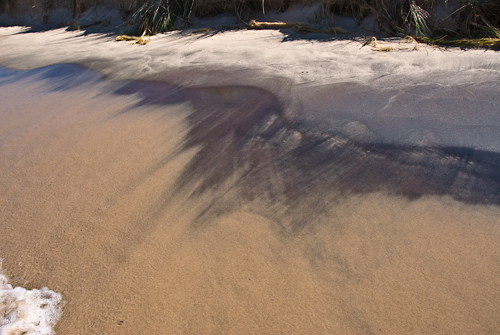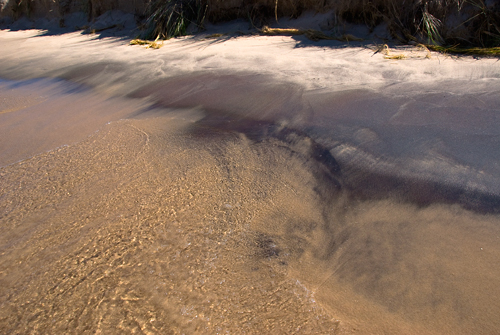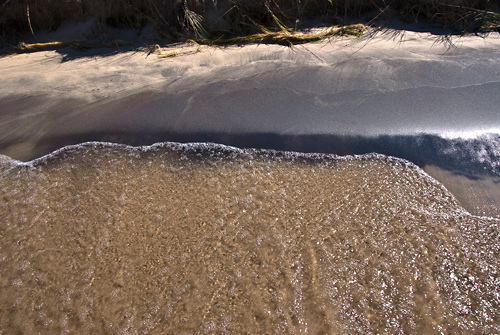Finely ground black sand overlies coarser light sand at a particular location along the shore of Lake Michigan.
Rough surf paints in black sand.




Starting this post, I thought that I would not dare to take these sand paintings of a Great Lake as motifs for my own oil painting. That was similar to my attitude towards a ‘stone painting’ done by the same Great Lake a few year ago with its receding water. The dropping water level exposed rocks arranged in wondrous ways. These stone people are now again submerged – mysteries in the sculpturing of the lake shore.
Thinking more about the sand paintings shown above, I am beginning to think that, with my increasing expertise, a few years from now, I may dare to portrait them, not in their exquisite detail, but rather in a more abstract fashion. That way, I would, in my own small way, follow the footsteps of such giants as Rothko and Turner, but doing so without permanently reducing my mind with, as my students now euphemistically say ‘substance use’ rather than ‘substance abuse’. In the meantime, interested in color interactions, I still have to learn a lot.
Is there a cycle of ‘colore versus disegno’ in a person’s life time as well as throughout the centuries?

I like this. It’s a bit disorienting and I enjoy that, you pick up more details that way.
Tree,
I like that, ‘disorienting’.
It lets me look at the images in a fresh way, not clouded by association of what the entire scene looked like when I took the images.
Birgit,
The dense drawings of your dark sand remind me of some of the Complexity drawings of Nelleke Beltjens. But I think I find the sand drawings more satisfying. Is it because, being constructed through natural forces, they represent something deep about how the world is?
I wonder whether the drawings by the three European women reflect an actual European tradition because I remember using such a technique at my German high school. It felt satisfying that out of the confusion of my curvy lines eventually a vague sort of a girl figure crystallized out.
Il Lee’s pictures remind me of Robert Motherwell’s Elegy to the Spanish Republic, 54 that I recently admired at MOMA. Its repetition of shapes struck me as clever because it led my eyes from left to right and back to left. I wondered whether my ‘nystagmus’ was due the fact that the leftmost shape is undeveloped and framed while going to the right, the shapes are more developed. [Not having much appreciated large abstract paintings, this one insinuated myself into my senses because it was in the same room as one of deKooning’s bizarre Women that I studied for a long time because of its colors. Across from the Motherwell was a very large brownish Rothko that left me cold.] Organization of shapes in space is of tantamount importance.
As you stated…One works in opposite ways in the two mediums: from simple up (drawing) or complex down (photography). …. I find it fascinating to apply that same idea to the work of a given artist. Will June’s landscape paintings become more simple or more complex?
Birgit:
Your first image is remarkable. The sand and the snow and the black streaks all conspire to create something wonderfully ambiguous. And speaking of place, if I wasn’t told otherwise, I would think this shot were taken on a tropical beach – snow notwithstanding.
Birgit:
Concerning Rothko I find his paintings tonal and easily swamped by an Elegy with its bold contrasts and insistent shapes.
Jay,
I played a trick on you. The images are from last summer, revisited now on my winter holidays. Thus, the white is foam, not snow. The last week, it has been incessantly snowing here in Northern Michigan and the beaches are indeed covered with snow.
The Rothko that I noticed at the MOMA, displayed across from the Motherwell, was murky brownish red without much contrast. I assume it is one of his later works when he gave up on strong colors. I cannot find it on the MOMA website. On the web, one finds the contrasty, colorful images that you mention.
Birgit,,
These images draw me in, make me want to do something with them. I’m glad to hear you are also drawn and thinking about painting.
I was just reading in the Henri Art Magazine an old review of a Picasso exhibit, posted on October 13, 2008 ( http://henrimag.com/blog1/?p=18 ). For some reason, your close observation and re-visiting this scene, re-imaging it in your mind made me think of the description of Picasso’s late work, in the 60’s. There’s nothing figurative here, but there’s a quality of present-ness that your pictures have which tugs me into them.
shockingly beautiful
Thanks, Gloria.